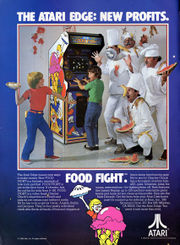Lost In Translation/Food Fight
| Food Fight | |
|---|---|
| Manufacturer | Atari |
| Released | 1982 |
| Control Method |
Analog joystick 1 Button(s) |
| Main CPU | 68000 (@ 6.048 MHz) |
| Sound CPU | Mono (3x) POKEY (@ 604.800 kHz) |
| Video Details |
Raster (Horizontal) 256 x 224 pixels 60.81 Hz 256 Palette colours |
| Screens | 1 |
| ROM Info | 12 ROMs 90,368 bytes (88.25 KiB) |
| MAME ID | foodf · foodf2 · foodfc |
About The Game
Food Fight is an arcade video game.
The player, as Charley Chuck, must dodge all kinds of flying fruit and vegetables and try to eat an ice cream cone before it melts. How many ice cream cones can he eat? Your players will soon find out in this incredible video feast. As an ice cream cone melts on the other side of the screen, Charley Chuck just naturally has to go for it, But he must get past Oscar, Angelo, Jacques and Zorba, four chefs who unexpectedly pop out of holes, chase Charley Chuck and throw food at him. They all have different personalities and they're all out to stop Charley Chuck if he isn't fast enough. There are piles of tomatoes, peas, bananas, pies and watermelon Charley Chuck can use to defend himself from the persistent chefs. The player controls Charley Chuck with an analog joystick which allows 360 degree movement on the playfield, and a Throw button, used when Charley Chuck needs to throw food at one of the chefs.
Trivia
Food Fight was designed for Atari by General Computing as part of a lawsuit settlement for an illegal speedup kit for "Missile Command", in which they affixed their copyright. This was one of two games; "Quantum" was the other. Inspired by the food fight scene in National Lampoon's Animal House.
This game has 125 recognized levels. On level 125 on the selection screen, it gives you the requisite free man with a ? above his head. While there are levels after 125, the game counter will not go that high. It should be noted that the gameplay on this high a level is very reflex/twitch oriented. Only those with ice coursing through their veins can decipher the action on the screen.
The game code shares a hidden message : HI JON.
Approximately 2,050 units were produced (only ~100 cocktail).
Ken Okumura holds the official record for this game on 'regular' settings with 103,103,100 points.
Jon Dworkin holds the official record for this game on 'Tournament' settings with 1,234,100 points on June 3, 2001.
A Food Fight unit appears in the 1985 movie 'Real Genius'.
In 1982, Atari released a set of 12 collector pins including : "Missile Command", "Battle Zone", "Tempest", "Asteroids Deluxe", "Space Duel", "Centipede", "Gravitar", "Dig Dug", "Kangaroo", "Xevious", "Millipede" and "Food Fight".
Scoring
| Action | Points |
|---|---|
| Hit chefs with food | 100 to 1,000 |
| Chef falls into hole | 200 |
| Eat the ice cream cone (levels 1-49) | Level x 500 |
| Eat the ice cream cone (levels 50 and above) | 25,000 |
| Each unused food at end of level | 100 |
Tips and tricks
Free men are awarded at 25,000 and at 100,000 thereafter.
The best way to get the ice cream in the later levels (level 85 or above) is to use the diagonal method. If you are placed close to a corner, run diagonally toward the lower wall and then diagonally upward toward the cone. Hopefully there will be some food placed between you and the chefs.
In later levels, it is NOT advised to try and target the chefs coming toward you. The only chef you need to concentrate on is the one running toward the ice cream in front of you.
Cabinet and Artwork
Ports
- Consoles
- Atari 7800 (1984)
- Atari XEGS
- Computers
- Tandy Color Computer (1983, "Foodwar")
- Atari 800 (1987)
- Others
- Atari Flashback Classic Game Console (2005)
Soundtrack Releases
| Album Name | Catalogue No. | Released | Publisher | Comments |
|---|---|---|---|---|
| Arcade Ambiance 1983 | N/A[1] | 2003-01-01 | Andy Hofle | Digital download only. |








